 Indian traditional wedding is full of different rituals and significant ceremonies. That’s because, in this country, everything has a symbolic meaning. We’d like to show you a Sikh traditional wedding with all its brightness and symbolism. Let’s look at the Sikh religious marriage ceremony and informal party with sweets and blessings. Of course, you won’t miss the extraordinary Indian traditional wedding clothing – beautiful ornate outfits that sparkle and shine. So, enjoy!
Indian traditional wedding is full of different rituals and significant ceremonies. That’s because, in this country, everything has a symbolic meaning. We’d like to show you a Sikh traditional wedding with all its brightness and symbolism. Let’s look at the Sikh religious marriage ceremony and informal party with sweets and blessings. Of course, you won’t miss the extraordinary Indian traditional wedding clothing – beautiful ornate outfits that sparkle and shine. So, enjoy!
The Anand Karaj, which means “blissful union” is a name of Sikh wedding ceremony. The foundation of the Anand Karaj was introduced by Guru Ram Das with the composition of the laavaan, a set of 4 hymns that describe the spiritual stages of married life.
Let’s find out what happens during a typical wedding day for Sikh couples.
Groom’s preparations for wedding
The day begins with the groom tying a turban and putting on a sherwani (ceremonial Indian suit).
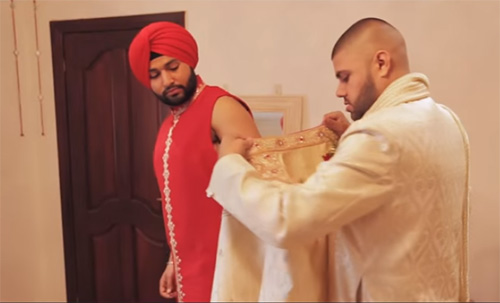
The groom sits next to a “sarbala” (young cousin or nephew that traditionally serves as the protector of a groom).
Groom’s sisters place the “palla” (ceremonial scarf) onto the groom and the groom’s mother places a coconut (called “nariel” – it signifies new beginnings) in the palla.
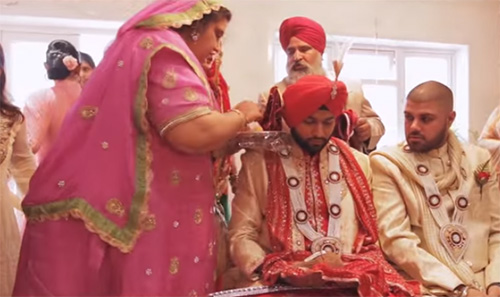
The groom's “bhabhi” (sister-in-law) adds “surma” (kohl, ancient eye cosmetic) to the groom’s eyes.
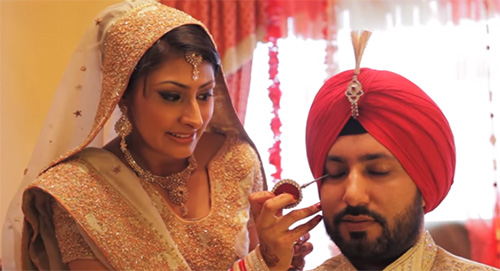
The groom’s sisters place a “kalgi” (special turban adornment) on the turban and, optionally, a “sehra” (ceremonial veil).
The groom's parents and siblings give “sagaan” (blessings) – usually, in the form of money, followed by “laddu”, traditional Indian sweets.
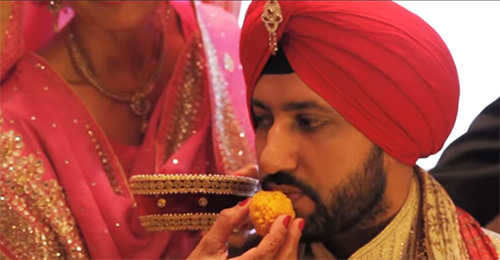
As the groom leaves the house, his mother pours mustard oil onto the doorstep. It is a ritual for when someone significant leaves or enters a home in India.
Unofficial celebration before the ceremony
The groom needs a “gurdwara” (so-called “gateway to the guru”, a Sikh place of worship) near the bride's house. Traditionally, the groom would ride a horse to the gurdwara. However, it is more common to see drummers accompany the groom.
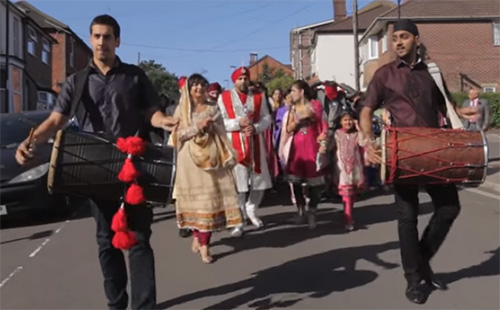
Once inside the gurdwara, a priest recites a specific prayer called “ardaas”. This prayer is said before and after significant religious occasions.
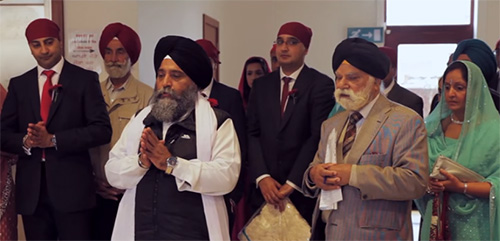
During the “milni” (meeting), the bride and groom's male family members meet each other. They shake hands, place a garland over each other, and sometimes the bride’s side offers gifts. Occasionally, they will wrestle and try to lift each other up in a friendly competition. The bride’s side offers the groom’s side Indian sweets.
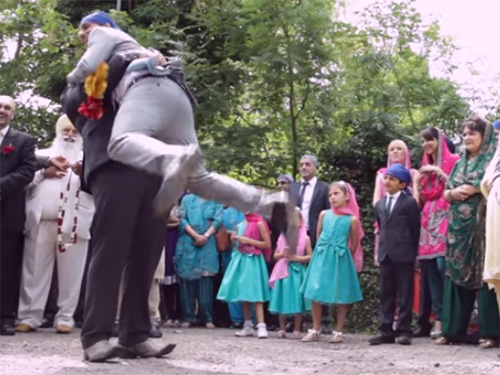
Both sides have the “langar hall” (kitchen) in the gurdwara for breakfast. This consists of savoury, spiced pastries, and sweets.
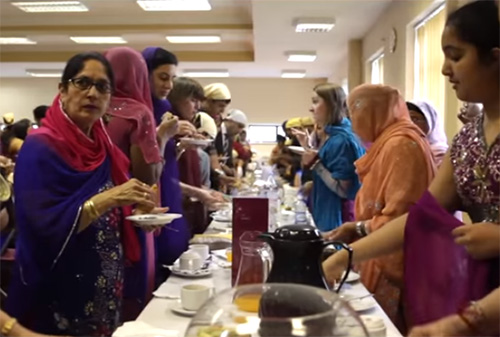
Religious part of wedding ceremony
The groom enters the “darbar” (court). He vows and touches his forehead on the ground in front of the “sri guru granth sahib” (central religious text and living guru). He may offer a “ramalla” (embroidered cloth) and then return to the male side of the congregation.
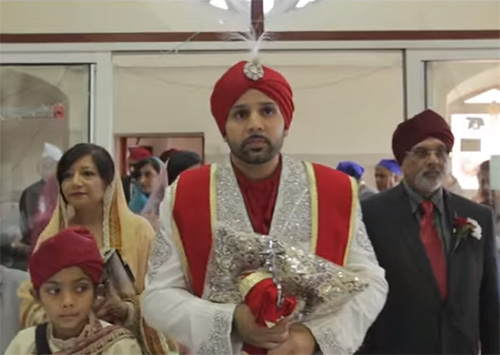
The groom’s sisters remove the ceremonial coconut from the morning.
The groom returns to the front, bows his head, and sits in the right. The groom's sisters arrange themselves behind him.
The bride enters, bows her head, and sits to the left of the groom. She may also offer ramalla.
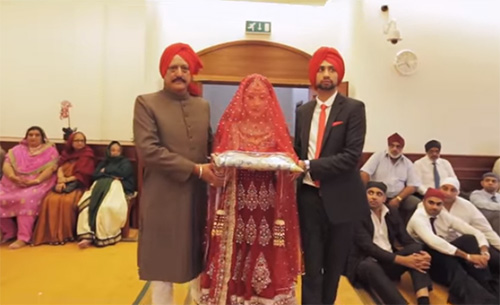
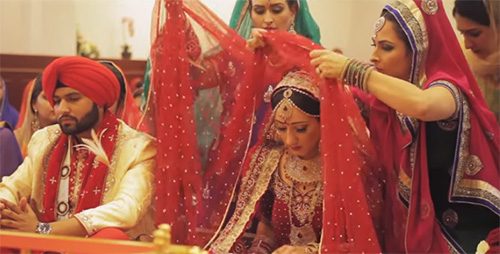
The bride's sisters arrange themselves behind the bride.
The bride, groom, and both sets of parents stand up while the priest recites the ardaas for the success of the marriage. By having the parents stand, they are consenting to the marriage.
During the palla ceremony, the bride’s father approaches the bride, takes the left side of the palla, and hands it over to the bride. This signifies the joining of the couple and the transferring of duty and responsibility to the groom.
The “lavaan” (marriage hymns) are the centerpiece of the Anand Karaj. The “granthi” (reader of sri guru granth sahib) recites the first of 4 wedding hymns, which progressively describes the joining of the bride, groom, and God.
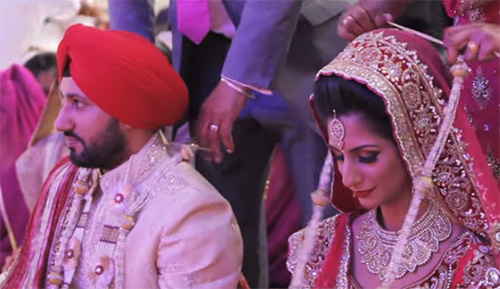
The “kirtani” (devotional musician) is dancing the same hymn as the bride and groom walk around the sri guru granth sahib clockwise. They will go around four times. The bride is commonly guided by her brothers. The kirtani sings two or three hymns on the subject of marriage.
To conclude the ceremony, the granthi reads a selected verse from a sri guru granth sahib.
Most ceremonies have a speech by an official representative of the gurdwara or a member of congregation. The congregation are then served “parshad” (blessed vegetarian pudding).
The sagaan ceremony begins with the bride's mother placing a coconut in the groom’s lap.
Both sets of parents place the garlands on the bride and groom, feed them laddu, and give them money.
The congregation also blesses the couple with gifts of money.
Doli ceremony
For the “doli” (bridal goodbye) ceremony, the bride’s sisters assemble a barrier on or near the entrance of the bride's house. The groom arrives with his closest friends and family. He bargains with the bride's sisters over an entrance fee. Eventually, a deal is reached. The groom is allowed to enter by cutting the barrier and dropping a coin in a glass of water.
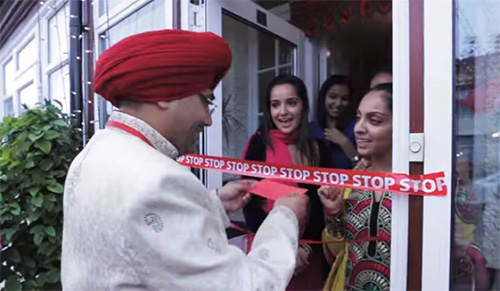
Mustard oil is poured onto the doorstep by one of the bride's sisters. The groom and his side enter the bride's home and have snacks before the bride prepares to leave the house.
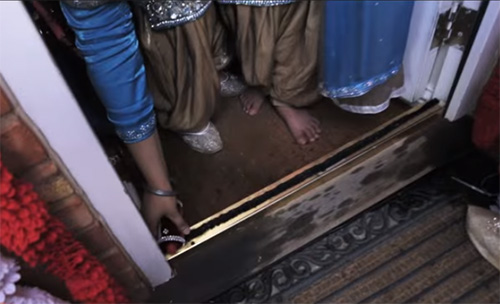
The bride comes downstairs and joins the groom with a given sagaan from the bride's parents. The bride's father hands over the palla to the bribe again. The bride stands up and throws rice in four directions before the groom leads her away through her house.
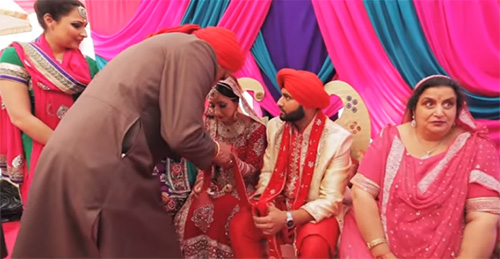
As they leave, mustard oil is poured onto the doorstep again.
The bride and groom step into the wedding car, where the bride says goodbye to her family and friends.
The bride's mother's brother throws coins in front of the car just before the brothers send off the car towards the groom’s house.
Pani bharna ceremony
For the “pani bharna” (water ceremony), the groom’s family gives the bride and groom laddu while they are still in the car. Once they reach the front of the groom's house, the groom's mother circles a jug of water around the bride and groom's heads and then tries to drink the water. The groom prevents her from drinking it on all but the last circle.
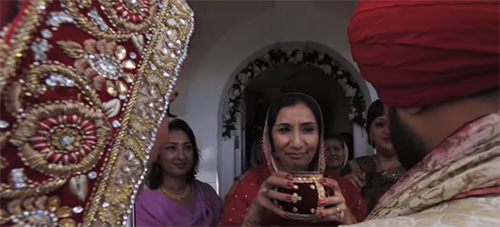
The bride and groom sit on the floor to get a sagaan and share a glass of milk.
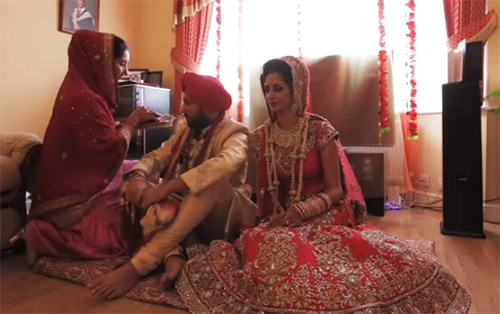
(c)


Comments